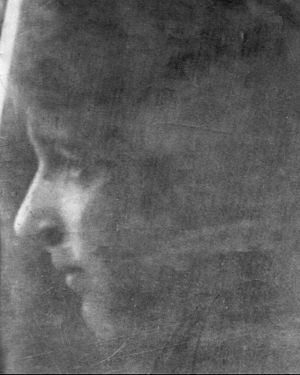María Zambrano facts for kids
Quick facts for kids
María Zambrano
|
|
|---|---|
 |
|
| Born |
María Zambrano Alarcón
22 April 1904 Vélez-Málaga (Málaga), Spain
|
| Died | 6 February 1991 (aged 86) Madrid, Spain
|
| Education | Complutense University of Madrid |
|
Notable work
|
El hombre y lo divino [Man and the divine], La Confesión [The Confession] |
| Awards | Príncipe de Asturias Award Cervantes Prize |
|
Main interests
|
poetry, mysticism, nihilism, religion, the human |
|
Notable ideas
|
poetical reason |
|
Influences
|
|
|
Influenced
|
|
| Signature | |
María Zambrano Alarcón (born April 22, 1904 – died February 6, 1991) was an important Spanish essayist and philosopher. She was part of a group of thinkers and writers known as the Generation of '36. María Zambrano wrote many books and essays that mixed ideas about society and deep thoughts.
Her work became widely recognized in Spain during the last part of the 20th century. This was after she had lived outside of Spain for many years. She received two very important awards: the Prince of Asturias Award in 1981 and the Miguel de Cervantes Prize in 1988.
Biography
María Zambrano Alarcón was born on April 22, 1904, in Vélez-Málaga, Spain. Her father, Blas José Zambrano García de Carabante, was a friend and helper of the famous writer Antonio Machado. Her mother was Araceli Alarcón Delgado.
In 1905, her family moved to Madrid. A year later, they moved to Segovia, where her father got a job teaching Spanish Grammar. María spent her teenage years in Segovia.
María Zambrano studied with and was influenced by the philosopher José Ortega y Gasset. She later taught metaphysics, which is a branch of philosophy, at Madrid University. She also taught at the Instituto Cervantes from 1931 to 1936.
During the 1920s and 1930s, she actively supported the creation of the Spanish Second Republic. This was a time when Spain became a republic again. However, she became disappointed with how political parties worked. Because of this, she decided not to become a Member of Parliament and stopped taking part in party politics.
When the Spanish Civil War began in 1936, she openly supported the Republic. After the Republic was defeated in 1939, she had to leave Spain and live in exile.
María Zambrano lived in many different countries. She lived in France, Mexico, Cuba, Puerto Rico, Italy, and Switzerland. She finally returned to Madrid in 1984, after the death of Francisco Franco, who had ruled Spain.
She passed away on February 6, 1991, in Madrid. She was buried in the cemetery of her hometown, Vélez-Málaga.
Recognition and Legacy
María Zambrano was respected by other thinkers and writers. She stayed in touch with important Italian thinkers. She also kept contact with Spanish writers like Rafael Alberti and Jorge Guillén.
Her work slowly began to be recognized in Spain starting in 1966. This happened when J. L. Aranguren published an article about her. The article was called "Los sueños de María Zambrano" (The Dreams of María Zambrano). It appeared in a very important cultural magazine called Revista de Occidente. This magazine was started by Ortega y Gasset, her former teacher. Many leading philosophers like Bertrand Russell and Edmund Husserl also wrote for it.
In 1981, María Zambrano received the Prince of Asturias Award. This was for her contributions to Communications and Humanities. It was the very first time this award was given. In 1983, Malaga University gave her an honorary doctorate. This means they recognized her great achievements.
In 1988, she made history by becoming the first woman to win the Miguel de Cervantes Prize. This is one of the most important literary awards in the Spanish-speaking world.
A film about her life, called María querida (Dearest Maria), was made in 2004. It was directed by José Luis García Sánchez.
In December 2007, a high-speed train line opened between Madrid and Málaga. The railway company RENFE renamed the Málaga train station María Zambrano. Also, the main library at her university, the Complutense University of Madrid, was named after her. In 2017, the city of Segovia officially declared her an adopted daughter of the city. The campus of the Universidad of Valladolid in Segovia is also named after her.
Philosophy and Ideas
María Zambrano believed there are two main ways people look at life: the philosophical way and the poetic way. Philosophy, she thought, often starts with big questions about the divine or how things work. People ask "what are things?" because they don't know the answers. This questioning comes from not knowing.
The poetic way, for Zambrano, is different. It's a calmer way of exploring answers. We are not driven by not knowing, but by our human desire to understand, to share, and to express ourselves.
Her way of thinking was shown through her unique writing style. She used creative language to express her ideas. This style was key to what she called her "method" of thinking.
Political Views
María Zambrano's work always had a political side. She showed this in different ways through her ideas. Her political actions were more direct before and during the Spanish Civil War.
However, she chose not to join any political party. She even turned down a seat in the General Courts (like a parliament) that was offered to her. She wanted to focus on her philosophical work. Yet, she did not stop thinking about politics. She believed that philosophy itself could guide how people live.
In her first book, Horizonte del liberalismo (1930), she wrote that "politics are done always when it is thought to direct life." This is what she aimed to do through her poetic writing, her criticism of harsh political movements, and her thoughts on reason.
Tributes
On April 24, 2017, Google honored María Zambrano with a special doodle on its homepage.
See also
 In Spanish: María Zambrano para niños
In Spanish: María Zambrano para niños

